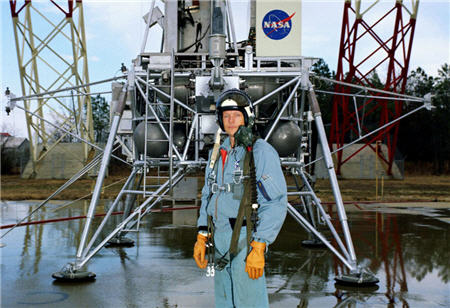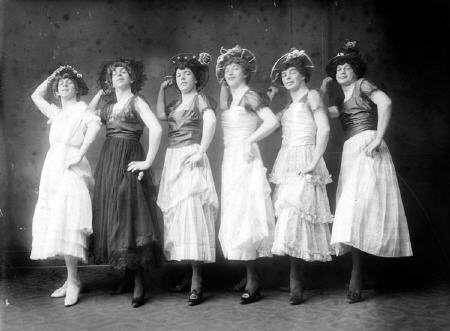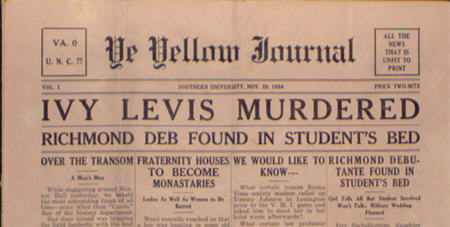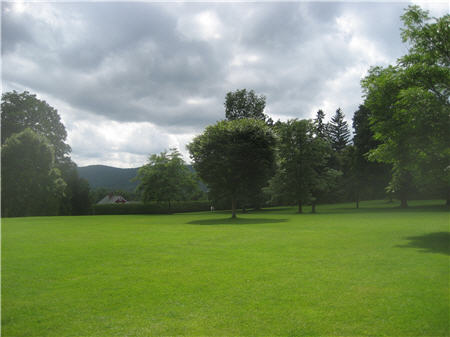-
LoJack is the sort of software that should be absolutely above reproach, because it’s used in a hostile attacker scenario and lives at a very very low level of the operating system. That it is easily hackable is, um, troubling.
Month: July 2009
Virginia Glee Club: the musical comedy years
No, that’s not a typo, and no, I didn’t post the wrong picture–at least, not if the attributions in the Holsinger Digital Collection at UVA are correct. Today’s stroll down history lane with the Virginia Glee Club covers an era in their history which is, perhaps justifiably, forgotten–their days as a musical theatre troupe.
To understand how a group founded on moonlight serenades, that eventually became a serious musical organization, spent time in the footlights with greasepaint and drag clothing, it’s helpful to go back to the re-formation of the Glee Club in 1910. At that time, the Glee Club, after a few years without any qualified student direction, reconstituted itself, responding, according to University historian Philip A. Bruce, to the disbanding of the musical theatre group the Arcadians. Through contemporary eyes, it’s easy to read this as meaning that the students from that group of musical players saw the error of their ways and became serious choral singers. Apparently not. Instead, this incarnation of the Virginia Glee Club appears to have arrived to fill a market void and spent at least some of its time doing real musical theatre.
And by musical theatre, I mean drag. The photo above, taken by the Holsinger photographic studio on April 4, 1916 (note the date), is attributed to the Glee Club with a question mark, as if to say, “No way!” Alas, other documentary evidence says “Way!” I have in my possession a copy of the April 1, 1921 edition of the Yellow Journal, the University’s anonymous satirical newspaper, in which a reviewer describes a performance of the Glee Club’s April Fools show for that year, “The Visiting Girl”:
“The Visiting Girl” presented by the University of Virginia Glee Club, John Koch, president, director and chief actor. Jefferson Theatre as an April Fool joke, April 1, 1921. We last saw this show in December and later we saw it in Richmond during February. If it hasn’t improved, and we doubt whether it has improved, we advise you not to go to see it. … The chief attraction of the show is Jack Parrott as a girl and John Koch as a rube. Jack plays his girl’s part very well, though he is a bit awkward. The girls’ chorus looks about as much like a bunch of girls as a litter of pups does. …
I could write it off as satire, but then there’s the ad in the back pages of the paper (the ads, while written to be funny, all are for real products or events):
TO-NIGHT
University Glee Club
IN A MUSICAL COMEDY
Suggestion: Why not cut out the “musical”?
Suggestion: They might cut out the “comedy” too.
The YJ’s hostility to the performance is partly a put-on (they spend the whole issue carping about class issues, and there’s “no one notable” in the Club), but the event is all real. It may well have been an April Fools tradition, judging from the dates of the evidence points, but the events were clearly real.
I would be remiss if I didn’t point out other photos from this era in the Holsinger archives. Yeah, the Glee Club did some of their “musical comedy” in blackface. I guess this isn’t surprising in a group doing musical comedy in the South in the early 20th century, but it’s still sobering to realize that the Glee Club really was of its time.
Grab bag: It might look easy but it’s not
-
Brent, as usual, does a thorough job of documenting why even small features take time and effort to do properly.
-
Our momentum release, or what I was working on when I wasn’t blogging this year.
Grab bag: Here comes the fun
-
A new children’s album about SCIENCE!!!!11!
-
Cory Doctorow points to an Ed Felten article that uncovers the reality of the AP “anti-copying” magic beans–it’s just the hNews microformat, which includes explicit rights definition (using ccREL, which only extends free use and the rights granted by copyright, not restricts them). Someone’s having an Emily Litella moment right now
-
Happy birthday to Doc!
-
Leave it to Cudlin to not bury the lede: “What does the world need? More videos of cats playing avant-garde 20th century music.”
-
Money quote in this article about the rising respectability of “food styling” in movies: “Mr. Flynn had to debone 60 ducks over the course of ‘Julie & Julia.'”
Grab bag: RIP George Russell, new life for Ounce Labs
-
RIP George Russell. I still like to go back and dust off his Ezz-thetics album.
-
This is what we mean by “can do.” Hope JPL finds a way to get the Rover moving again.
-
IBM acquires one of the standalone pure play static analysis source vendors.
-
Well done, guys. Makes me proud to be a Wahoo.
-
A passing review of the Reqiuem where the reviewer apparently attended a different performance than the one I performed.
-
Comprehensive and educated review of Saturday’s Brahms Requiem performance. Will have to go back and listen to that Schütz now.
“A 1982 Impala with blown shocks”
-
Nicholson Baker writes a marvelous essay on the hatchet job the Kindle does for the reading experience–but in the end, with a novel, he’s hooked. Illustrated and technical books don’t fare as well in the user experience department. Moving from reading eBooks on the iPod Touch to the Kindle, he writes: “Then, out of a sense of duty, I forced myself to read the book on the physical Kindle 2. It was like going from a Mini Cooper to a white 1982 Impala with blown shocks.”
Byte code analysis is not binary analysis
-
Gartner’s Neil MacDonald lays out the difference between bytecode analysis and binary analysis. Veracode does binary, and is the only vendor to offer binary analysis of C/C++ apps.
Grab bag: AP goes nuclear; iPhone encryption hacked
-
Quoth Gruber: “Someone just sold the Associated Press a bag of ‘magic beans.'” One wonders what this “digital wrapper” was supposed to be anyway.
-
Those fools.
-
With physical access and a jailbreak, you can apparently get even supposedly encrypted data off an iPhone.
The First and Second Comings of the Yellow Journal
I’ve had the pleasure this week of collaborating with an anonymous Wikipedia editor on a history of the Yellow Journal–that scurrilous student humor magazine at the University of Virginia. In the process we found more than a few interesting points, like:
- The Yellow Journal was originally founded in 1912 by the journalistic fraternity Sigma Delta Chi, later to become the Society of Professional Journalists! Anyone who saw the 1990s incarnation (which I had a small hand in) knows how unlikely that origin story is… but it’s not only true, it’s attested in an official UVA history (Dabney, pp. 98-99).
- Perhaps because of the ΣΔΧ connection, the early Yellow Journal got press in the New York Times! The Times, which up through the 1930s still published bulletins about social doings in Charlottesville, had a nice article in 1913 about Easters which included a description of the Yellow Journal which is dead on: “…did not spare individuals, events or institutions in its ridicule and quips. It was well illustrated with appropriate cartoons. The character of the sheet can be best gathered from its motto, which is one of Mark Twain‘s witticisms: Truth is precious–therefore economize with it.”
- The YJ was first shut down over its scurrilous anonymity — presumably a perceived violation of the honor code–rather than its equally scurrilous content. (See, for instance, headline on the final 1934 edition above.)
- The reincarnated 1990s version of the Yellow Journal got tied up in UVA’s Supreme Court case over the funding of Wide Awake, thanks largely to the issue with the Sinéad O’Connor inspired picture of Pope John Paul II with the legend, “Tear Here.” As a result, about the only thing you can find about the late era YJ on Google is that it was “a humor magazine that has targeted Christianity as an object of satire.”
- The YJ’s “rejected Dr. Seuss titles,” originating as kickers (jokes along the bottom of each page) in a 1990-1991 issue, turned into a veritable Internet meme.
Alas, there isn’t much out there generally about the YJ. But a few alums and I have been thinking about republishing some of the best content from the 1990s run, maybe even turning it into something like a proper book. I’d love to hear from any Virginia alum who thinks that’s a great idea–or a terrible one. Also, if there are favorite memories about the YJ, please share in the comments.
At Tanglewood with the Brahms Requiem
It was a dramatic day at Tanglewood yesterday. I took the day off from work to attend two rehearsals for this weekend’s performance of the Brahms Requiem. The sky was obligingly threatening for most of the afternoon, but the sun was out and the juxtaposition of green lawn (greener for all the rain we’ve had this summer) and stormy skies called out to me.
We sang the piece through from start to finish once yesterday in piano rehearsal with Maestro Levine (omitting the fifth movement, as our soprano, Hei-Kyung Hong, was not at the rehearsal and because there’s not so much for the chorus that it merited visiting without her), and then re-ran the first, second, fourth, and sixth movements with the orchestra. With that much time immersed in the piece, I had a chance to revisit my thoughts about performing the Requiem as a chorister from last fall, and got some clarity on the technical challenge of the piece. Last fall, I wrote:
… the profile of the work from an emotional perspective is low – high – very high – moderate – low – very high – high, but the technical difficulty profile is basically high – very high – very high -high – high – very freaking high – high, and you have to really husband your emotional and physical energy accordingly.
The alternative: you hit the wall sometime around the sixth movement, the real uphill battle of the work, before you even get into the fugue. And in that fugue, as our director said, there is inevitably “blood on the walls” in every performance thanks to the demand on the singers and the difficulty of the preceding music.
Yesterday I found what may be the real culprit of the sixth movement, for me at least. It’s not just the overall arc of the piece, but specifically the tenor part immediately preceding the fugue, where all choral voices respond to the baritone’s “…wir werden aber all verwandelt werden; und dasselbige plötzlich, in einem Augenblick, zu der Zeit der letzen Posaune” (we will all be changed, in a moment, in the twinkling of an eye). The choral text that follows is at the heart of Brahms’ conception of the work, and speaks of the Resurrection:
Denn es wird die Posaune schallen, und die Toten werden auferstehen unverweslich, und wir werden verwandelt werden. Dann wird erfüllet werden das Wort, das geschrieben steht: Der Tod ist verschlungen in den Sieg. Tod, wo ist dein Stachel? Hölle, wo ist dein Sieg?
…for the trumpet shall sound, and the dead shall be raised incorruptible, and we shall be changed. Then shall be brought to pass the saying that is written, Death is swallowed up in victory. O death, where is thy sting? O grave, where is thy victory?
And the text is sung at absolutely full volume over some of the thickest orchestration in the work, and in the high part of the tenor range.
This is the rub, at least for me. The need to support the voice is strong, but at that volume and emotional fervor it’s very easy to tip over from supporting to tightening, and then the battle is lost and the voice closes progressively until it is difficult to get any sound out at all. Once that happens the following fugue is unsingable.
I will work for the next few days on avoiding the tightness, but I definitely have proof that this is a key danger area. We sang through once and I experienced the effect I describe above. Then we stopped for a bit to discuss some issue in the orchestra, and I collected myself and caught my breath. When we returned, Maestro Levine started us on the last “Wo? Wo? Wo ist dein Seig?” — and despite its starting at a high F, I was singing it clearly and unencumbered. I had relaxed and allowed my vocal apparatus to resume something like a normal position, and my voice was back.
It’s days like yesterday that I remember all too well that I’ve only had about four voice lessons in my life, and they were over 20 years ago. Maybe it’s time to go back and learn some proper technique. I’m starting to get a little too old to figure this stuff out on the fly.
Grab bag: Common sense and the F-22
-
Easy way to force a browser to display RSS as plain XML.
-
Finally, some common sense surfaces in Congress. If we can say no to the F-22, the sky is the limit! Maybe.
-
Most of these are also the top lies of product managers.
Grab bag: MCA and the big C; Apollo at 40
-
Fingers crossed that MCA makes it through without complications.
-
Personal history of the Apollo program from Phil Plait. I feel the same way about Columbia.
-
Amateur astronomer discovers an impact site on Jupiter, where a comet or asteroid has crashed into the atmosphere near the pole.
-
“Cronkite understood that the ultimate role that journalism can be forced to play in democracy is, quite simply, to fight to preserve democracy itself, and that the greatest threat to our republic was when elected leaders choose to lie to the American people. That didn’t mean abandoning the core principles of journalism — aggressive fact finding, which includes first-hand observation and talking to all sides, as Cronkite did on his trip to Vietnam, or an innate sense of fairness and justice. But he knew that journalism was more than rote stenography –parroting the untruths that LBJ and the Pentagon said about the war and finding a political opponent to quote deep down in the story for “balance.” He knew there could be a time when the only way to inform the American people of a higher truth was to step outside the straight jacket of objectivity.”
-
John “JP” Park shows how he built a “mystery box” for Wired’s Geekdad columnist John Baichtal.
-
The chain of failure for Twitter’s internal documents, unsurprisingly, includes Hotmail, Gmail, Google Docs–and weak passwords and password reuse.
-
Stirring essay about Long Island’s ties to spaceflight and the construction of the lunar landers.
-
Talk about transparent. The White House blog announces webinars about the transparency provisions in the Recovery Act and provides a full schedule.
-
I’ll be providing some of the “weighty German rhetoric” next Saturday, singing the Brahms Requiem as part of the Tanglewood Festival Chorus.
-
It’s really, really hard to get good quality photos that meet the copyright test. There are a ton of articles I’ve written where there are no free images available for use.
Grab bag: Cronkite, on the eve of Apollo 11’s 40th
-
It seems somehow appropriate and sad at the same time that Walter Cronkite should pass away just before the Apollo landing anniversary. One thinks he would have liked to see it again.
-
Poor reporting job amplifies the hoaxer message beyond balanced reporting. This is crap.
Preparing to land on the moon

The anniversary of the first moon landing, on July 20, 1969, is always a special occasion for me. It’s my dad’s birthday too, and he was a NASA employee for over 30 years, so the story of the space program is the story of my childhood. I was too young to watch any of the moon landings on TV–hell, Apollo 17 took off when I was 5 days old, and the last Skylab mission happened when I was only 18 months old. But I was always hanging out at NASA Langley with Dad, whether it was for mundane reasons (eating lunch in the cafeteria, playing on the playground, going to the Visitors Center, now the Virginia Air and Space Center) or for historic occasions. I was in the main auditorium with Dad when the videos from the first Voyager flybys of Saturn came in, and for other flybys. And I feel a deep sense of family connection to the space program as a whole.
But I had never seen the photo reproduced above until today. When I was a summer intern at NASA Langley in 1992, I drove alongside what looked like a massive abandoned facility. Red girders above, cracked tan pavement below, weeds around. “It was the Lunar Landing Research Facility,” my dad told me. Apparently they suspended a mockup of the lander from the girders to simulate moon gravity, and the astronaut or research pilot would practice piloting it. I never actually saw a period photo of the facility, though, until today’s Boston.com Big Picture feature, which includes the photo reproduced above of Neil Armstrong at the LLRF. The facility is apparently still in use today for “impact testing” (crashing) aircraft. (More details about the LLRF and Langley’s other contributions here).
I suppose this attachment to NASA explains my visceral reaction to the ongoing “moon landing hoax” foolishness (I would have been right alongside Buzz Aldrin in punching Bart Sibrel in the face). Thanks to Bad Astronomer Phil Plait for his many good humored but thorough debunking blog posts on the subject.
In the meantime, I’m enjoying the non-hoax-related coverage of the anniversary, including @AP11_CAPCOM, @AP11_SPACECRAFT, and @AP11_EAGLE on Twitter. You may want to follow @AP11_MOON as well.
Grab bag: Certifications and reality
-
You too can be a Certified ASS (Application Security Specialist)!
-
Talking Points Memo points up the difference between right wing advocacy and left wing news gathering in the Sanford case.
-
Chris Eng breaks open the BlackBerry spyware.
-
The issue for this migration will be IE-only applications. This is why your staff always begged you to deploy a web app that was reliably cross browser.
-
Underscores the importance of information security assessments for mobile applications.



